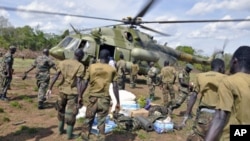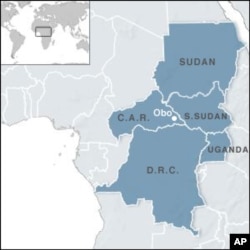In a one-room radio station deep in the forests of the Central African Republic, an announcer broadcasts a message to those kidnapped by the Lord's Resistance Army.
Come home, the message says, your family will accept you, no matter what atrocities you may have committed.
Emmanuel Daba, one of the hosts at the U.S.-funded Radio Zereda, was kidnapped by the LRA in 2008 and served as a porter for the rebels for a year, before he escaped.
“We conducted raids on villages in South Sudan and the Congo,” he said. “We killed a lot of people, with machetes, with sticks and clubs.”
Daba was one of the thousands abducted by the LRA since it first launched an insurgency in Uganda 20 years ago, led by the notorious and elusive commander Joseph Kony.
Since then, the group has spread out into South Sudan, the Democratic Republic of Congo and the Central African Republic. Once numbering in the thousands, the LRA now is believed to have only a few hundred fighters at most.
While their numbers have diminished, their ability to inflict terror has not. The United Nations estimates that 465,000 people were displaced last year because of the LRA threat.
Guiding the 'pointy end'
Last year, U.S. President Barack Obama authorized the deployment of about 100 U.S. special forces troops to help capture or kill members of the LRA.
Small teams of soldiers have helped set up operating centers in five locations across central Africa.
The head of U.S. counter-LRA operations, Navy Captain Ken Wright, said the soldiers' role is to work in the background, to actively support regional militaries.
“They are the ones who will go out and affect the capture of Joseph Kony on the battlefield,” he said, “We don't need to be at the pointy end of a patrol to affect and support their actions.”
In Obo, U.S. soldiers share information with their counterparts from the Ugandan and Central African Republic militaries at the Counter-LRA Operations Fusion Center [COFC]. The center is housed in a small building that once belonged to a doctor murdered by the LRA. Maps of central Africa adorn the walls of the meeting room, along with pictures of the LRA commanders, including Kony.
The room is open to members of the local communities, as well as hunters and nomadic herdsmen who may have information to share about the LRA's whereabouts.
Wright said this information sharing is bringing the joint forces closer to tracking down the group's senior leaders.
“Every day we are out here working with our partner nation forces, we develop a better understanding of the LRA and their location in the battle space,” he said. “Every day that view is refined more and more.”
Ugandan military spokesman Colonel Felix Kulayigye said U.S. intelligence support could be the turning point in the hunt for Kony.
“As you are aware, a military without intelligence is as good as a blind person,” he said. "We believe this support will definitely help us capture Kony, or kill him.”
Where is Kony?
Tracking the rebel leader is a major challenge. LRA fighters have all but abandoned using mobile or satellite phones to communicate with one another, making them very difficult to trace.
Dispersed across an area the size of California, the LRA moves in small groups, only occasionally meeting up at pre-determined rendezvous points.
Kulayigye says the latest intelligence reports suggest Kony is somewhere in the Central African Republic, though he previously said the rebel leader was in the southern Darfur region of Sudan.
Mathew Brubacher, the political affairs officer for the U.N. peacekeeping mission in the DRC, has been studying the LRA for nine years, and regularly interviews abductees who have been released or freed from the group, looking for information about their leaders.
Brubacher also had heard Kony may have been in Sudan, but said that information is difficult to verify.
“I imagine he's just moving around,” he said, “crossing borders frequently, probably with a fairly small group with a bigger group providing extra support. That's the way he usually moves.”
Wright said the LRA's small group numbers pose a unique challenge, but that military pressure is working.
“Their ability to negatively affect the environment and the people around them is greatly reduced,” he said. “They are almost on a survival mode at this point.”





